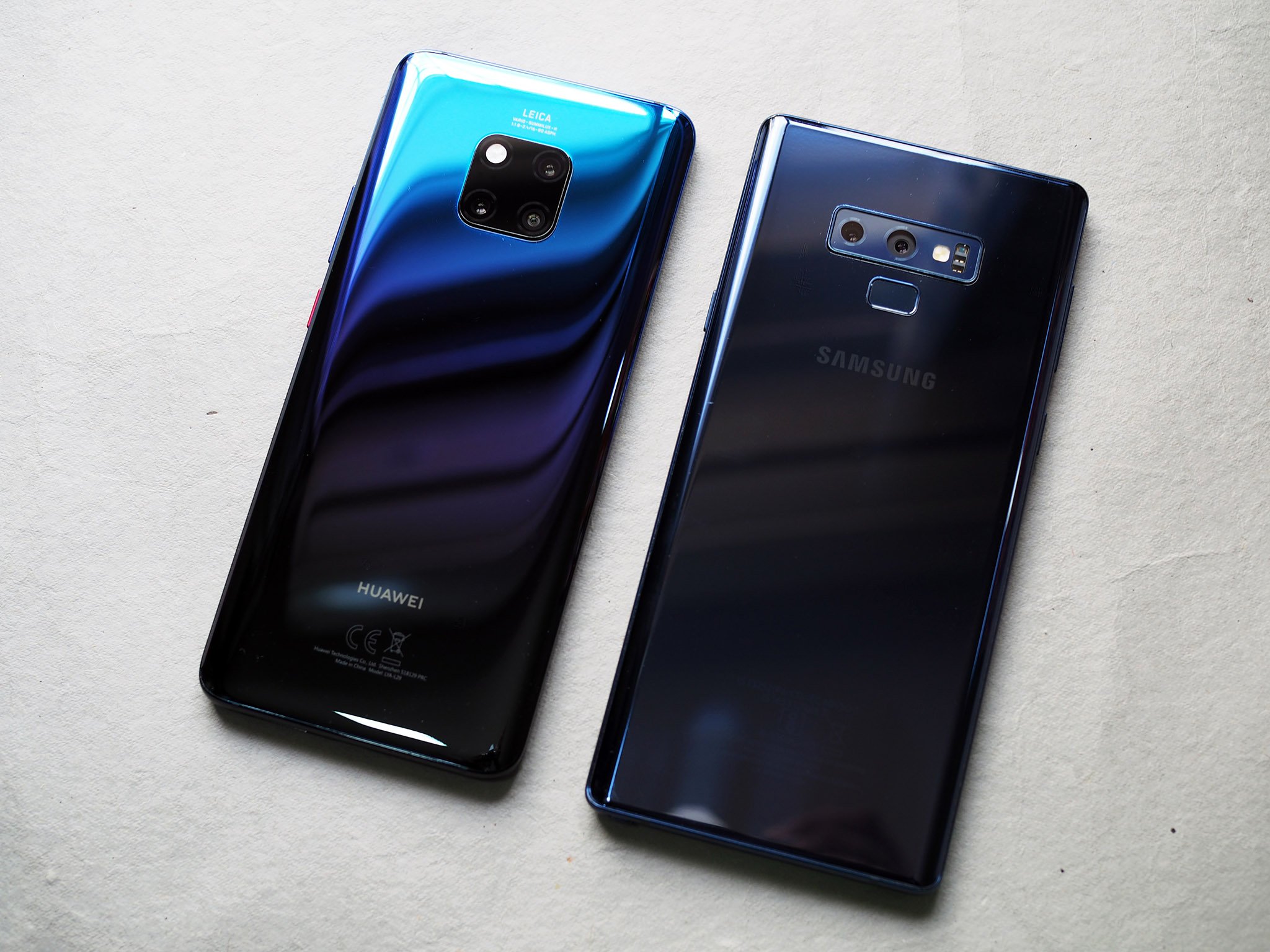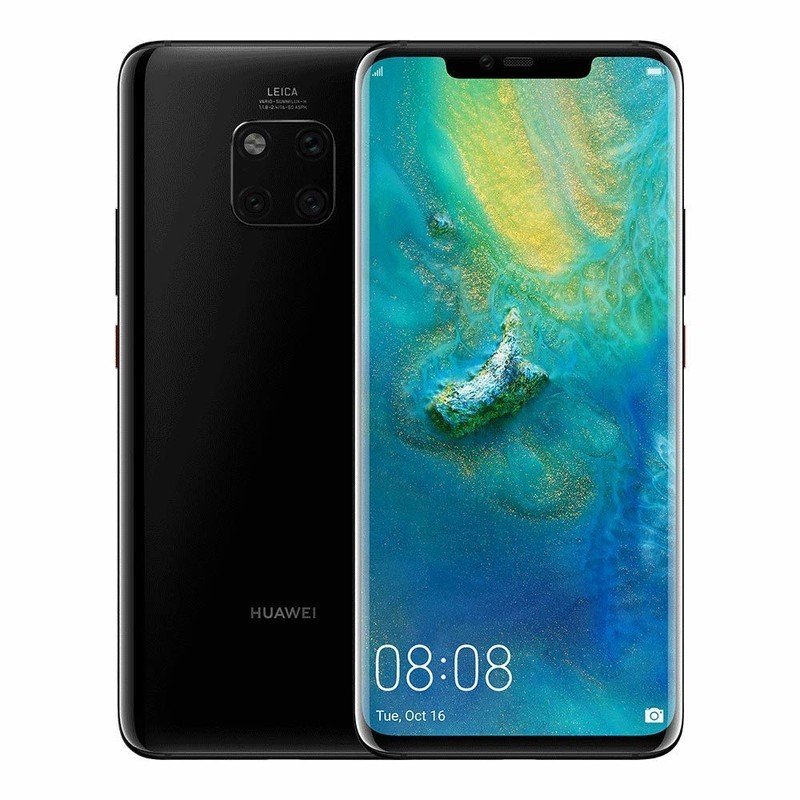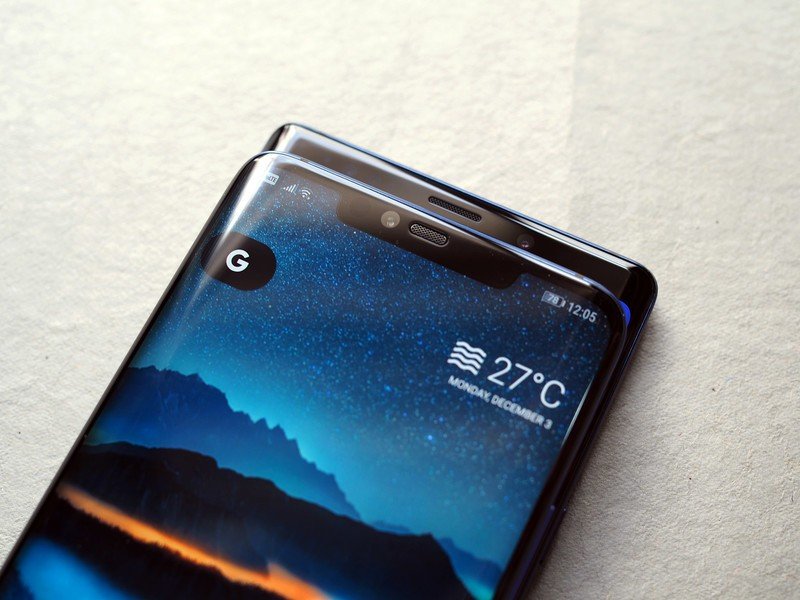Huawei Mate 20 Pro vs. Samsung Galaxy Note 9: Which should you buy?

Huawei Mate 20 Pro

Featuring the latest 7nm Kirin 980 chipset, the Mate 20 Pro offers an early look at what's in store for 2019 flagships. The phone has a sleek design paired with incredible cameras that hold their own next to the Note 9. Combine that with two-day battery life and it's easy to see why the Mate 20 Pro is one of the best phones right now.
Huawei Mate 20 Pro
Cutting-edge
Samsung Galaxy Note 9

The defining trend of 2018 on Android is the display notch — thankfully, Samsung is one of few manufacturers that refused to go down this route. The Note 9 builds on the strengths of the S9+ while offering a much-needed upgrade on the battery front, a retooled S Pen, and the now-standard laundry list of features that made the Note line a success.
Samsung Galaxy Note 9
Zero compromises
With Huawei effectively barred from the U.S., the Chinese manufacturer is looking elsewhere to fuel growth. That has meant a more aggressive push in Asian markets as well as building on its presence in the UK and the Middle East. With the Galaxy Note 9, Samsung is sticking with a formula that has worked in the past. The phone shares a similar design aesthetic as its predecessor, but comes with a much larger battery and an all-new S Pen that enables new experiences.
Should you buy the Huawei Mate 20 Pro or the Galaxy Note 9?
2018 was the year Huawei raised its game on the smartphone front. The Mate lineup was always well-regarded among power users for offering large screens coupled with huge batteries, and while the Mate 20 Pro fulfils that requirement, it also introduces a new design language that justifies its exorbitant price tag.
The Mate 20 Pro comes with a dual curved AMOLED display — similar to what you'd find on the Galaxy S9+ — with matching curves at the back. In fact, the design is near-identical to the S9+ that it's easy to assume the device was manufactured by Samsung. Huawei does differentiate the design via the signature camera housing at the back that's modeled after Porsche's four-point headlights, and gorgeous color options.
Meanwhile, the Note 9 shares a similar aesthetic as its predecessor, with a large rectangular frame sandwiched by glass on both sides. The rounded corners and subtle curves make the Note 9 much better to hold than the S9+, but there's no getting around the fact that this is a large phone.






The Mate 20 Pro wins by a considerable margin when it comes to in-hand use, an achievement in and of itself as it has a larger battery and a similar screen size as the Note 9. Huawei was able to cut down on the size by adopting a notch, but thankfully there's an option to disable it. Both devices feature QHD+ AMOLED displays, but Huawei isn't sourcing its panels from Samsung. The Note 9 takes the lead both in terms of vibrancy and sunlight legibility, but not by a huge margin.
Be an expert in 5 minutes
Get the latest news from Android Central, your trusted companion in the world of Android
On the biometric front, Samsung continues to offer a traditional fingerprint reader, with Huawei switching to an in-display solution. The sensor on the Note 9 is faster and more reliable, and it is easily accessible with your finger thanks to the positioning underneath the camera sensor, unlike last year.
Samsung also offers an iris scanning option, while Huawei has a 3D face unlock feature that relies on an IR sensor and a flood illuminator that takes up to 30,000 facial data points to accurately identify your features. Huawei's solution wins out in this area, as Samsung's iris scanning takes a while to authenticate.
The S Pen continues to be a differentiator for Samsung.
Both phones have a laundry list of features, but the Note 9 wins out here: It comes with a headphone jack, and Samsung Pay continues to be the best mobile payments system around. Then there's the S Pen, which has been redesigned this year. It now works with Bluetooth, and I ended up using it as a remote shutter for the camera most of the time. You can also launch apps with the S Pen, and assign single- and double-click actions for the button on the stylus.
Like years past, the S Pen continues to be a differentiator for the Note lineup, and the new set of features that debuted with the Note 9 make it an even more compelling option.
That said, there's a clear winner when it comes to the internal hardware. The Mate 20 Pro with its 7nm Kirin 980 is one of the fastest phones I've used to date, and while the Note 9 doesn't feel sluggish by any stretch of the imagination, it just can't keep up with the Mate 20 Pro. For what it's worth, I'm using the Exynos 9810 version of the Note 9.
| Category | Huawei Mate 20 Pro | Samsung Galaxy Note 9 |
|---|---|---|
| Operating system | Android 9.0 PieEMUI 9.0 | Android 8.1 OreoSamsung Experience 9.5 |
| Display | 6.39-inch AMOLED, 3120x1440 (19.5:9)HDR10 | 6.4-inch Super AMOLED, 2960x1440 (18.5:9)Gorilla Glass 5 |
| Chipset | Kirin 980 | Qualcomm Snapdragon 845 (U.S., China)Exynos 9810 (ROW) |
| GPU | Mali-G76 MP10 | Adreno 630Mali-G72 MP18 |
| RAM | 6GB/8GB LPDDR4X | 6GB/8GB LPDDR4X |
| Storage | 128GB/256GB UFS2.1 | 128GB/512GB (UFS 2.1) |
| MicroSD slot | No (Nano Memory) | Yes |
| Rear camera 1 | 40MP f/1.7, OIS4K@30fps, 720p@960fps | 12MP f/1.5 or f/2.4, OIS4K@60fps, 720p@480fps |
| Rear camera 2 | 20MP f/2.2 wide-angle | 12MP f/2.4 telephoto, OIS |
| Rear camera 3 | 8MP f/2.4 telephoto | None |
| Front camera | 24MP f/2.0 | 8MP f/1.7 |
| Connectivity | Wi-Fi 802.11ac 4x4 MIMO, Bluetooth 5.0 LE, NFC, GPS | Wi-Fi 802.11ac 2x2 MIMO, Bluetooth 5.0 LE, NFC, GPS |
| Audio | USB-CStereo speakers | 3.5mm jackStereo speakers |
| Battery | 4200mAhNon-removable | 4000mAhNon-removable |
| Charging | USB-CFast charge (40W) | USB-CFast charge (18W) |
| Water resistance | IP68 | IP68 |
| Security | In-display fingerprint sensor3D face unlock | Fingerprint sensorIris sensor |
| Dimensions | 157.8 x 72.3 x 8.6mm189g | 161.9 x 76.4 x 8.8mm201g |
| Colors | Twilight, Emerald Green, Midnight Blue, Black | Lavender purple, Ocean Blue, Midnight Black |
There's little to differentiate between either device when it comes to the camera side of things. You get excellent images from both devices, but the Mate 20 Pro has more shooting modes owing to the fact that it has three imaging sensors at the back. The wide-angle lens in particular is a great addition, and allows the Mate 20 Pro to stand out. Huawei's retooled night mode also works better than Samsung's offering.

Both devices also offer IP68 dust and water resistance, as well as wireless charging. But the Mate 20 Pro is the outright winner when talking about battery life. My Note 9 delivers a day's worth from the 4000mAh battery, but the Mate 20 Pro had no issues lasting two days on a full charge from the 4200mAh battery. Huawei also has a sizable lead when it comes to charging — its 40W fast charging standard is one of the best around. Meanwhile, Samsung's fast charging standard hasn't seen an update for a few years now, and is in sore need of an upgrade.
The Mate 20 Pro runs rings around the Note 9 when it comes to battery life.
There's a similar story when talking about the software. The Mate 20 Pro comes with the latest version of EMUI based on Android 9.0 Pie out of the box, and the Note 9 is still running Oreo. Samsung's One UI looks like a much-needed change in the right direction, but it's likely the stable Pie update won't be hitting the Note 9 until early next year.
At the end of the day, you can't really go wrong with either the Mate 20 Pro or the Note 9. There are many similarities between both devices, and at the end of the day it comes down to what you're looking for in a phone. If you value the added functionality offered by the S Pen, then the Note 9 is the obvious choice.
But if you want a device that offers the latest hardware and two-day battery life, then the Mate 20 Pro is the default pick. The fact that the Mate 20 Pro isn't available in the U.S. makes this a moot point, but for those in Canada, the UK, and other markets where Huawei is selling the Mate 20 Pro, the device is a viable alternative to the Note 9.

One of the best phones of 2018.
The Mate 20 Pro brings a slate of features that allows it to stand out in this space. The battery life in particular is outstanding, and we'll have to wait until 2019 to see flagships with the same level of hardware. The evocative design along with the great cameras and 3D face unlock make it a great alternative to the Note 9.

Stellar hardware backed by a powerful stylus.
Samsung continues to lead the way when it comes to the sheer number of features on offer. The Note 9 combines a gorgeous AMOLED screen with a great S Pen that unlocks new functionality. The camera is one of the best you'll find on Android, and the Note 9 is an all-rounder that continues to be a great option.

Harish Jonnalagadda is Android Central's Senior Editor overseeing mobile coverage. In his current role, he leads the site's coverage of Chinese phone brands, networking products, and AV gear. He has been testing phones for over a decade, and has extensive experience in mobile hardware and the global semiconductor industry. Contact him on Twitter at @chunkynerd.
